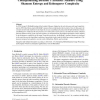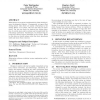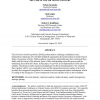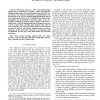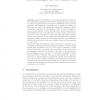93 search results - page 12 / 19 » The Transformational Creativity Hypothesis |
CAE
2007
13 years 10 months ago
2007
In 1928, George D. Birkhoff introduced the Aesthetic Measure, defined as the ratio between order and complexity, and, in 1965, Max Bense analyzed Birkhoff's measure from an i...
MSR
2006
ACM
14 years 1 months ago
2006
ACM
Refactorings are program transformations which should preserve the program behavior. Consequently, we expect that during phases when there are mostly refactorings in the change hi...
ISEM
2007
13 years 7 months ago
2007
The electronic market hypothesis (EMH) predicts that by reducing coordination costs, information technology (IT) will shift industrial organization from hierarchical to market-bas...
TSP
2008
13 years 7 months ago
2008
This paper presents a novel and mathematically rigorous Bayes recursion for tracking a target that generates multiple measurements with state dependent sensor field of view and clu...
ALT
2006
Springer
14 years 4 months ago
2006
Springer
Most of the existing active learning algorithms are based on the realizability assumption: The learner’s hypothesis class is assumed to contain a target function that perfectly c...
